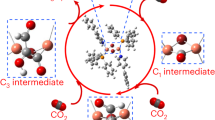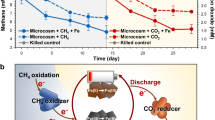Abstract
New electrochemical ammonia (NH3) synthesis technologies are of interest as a complementary route to the Haber–Bosch process for distributed fertilizer generation, and towards exploiting ammonia as a zero-carbon fuel produced via renewably sourced electricity1. Apropos of these goals is a surge of fundamental research targeting heterogeneous materials as electrocatalysts for the nitrogen reduction reaction (N2RR)2. These systems generally suffer from poor stability and NH3 selectivity; the hydrogen evolution reaction (HER) outcompetes N2RR3. Molecular catalyst systems can be exquisitely tuned and offer an alternative strategy4, but progress has been thwarted by the same selectivity issue; HER dominates. Here we describe a tandem catalysis strategy that offers a solution to this puzzle. A molecular complex that can mediate an N2 reduction cycle is partnered with a co-catalyst that interfaces the electrode and an acid to mediate proton-coupled electron transfer steps, facilitating N−H bond formation at a favourable applied potential (−1.2 V versus Fc+/0) and overall thermodynamic efficiency. Certain intermediates of the N2RR cycle would be otherwise unreactive via uncoupled electron transfer or proton transfer steps. Structurally diverse complexes of several metals (W, Mo, Os, Fe) also mediate N2RR electrocatalysis at the same potential in the presence of the mediator, pointing to the generality of this tandem approach.
This is a preview of subscription content, access via your institution
Access options
Access Nature and 54 other Nature Portfolio journals
Get Nature+, our best-value online-access subscription
$29.99 / 30 days
cancel any time
Subscribe to this journal
Receive 51 print issues and online access
$199.00 per year
only $3.90 per issue
Buy this article
- Purchase on Springer Link
- Instant access to full article PDF
Prices may be subject to local taxes which are calculated during checkout




Similar content being viewed by others
Data availability
Details on the procedures and the corresponding datasets generated during and/or analysed during the current study are available within the paper and its Supplementary Information files, and from the corresponding author on reasonable request.
References
Martín, A. J., Shinagawa, T. & Pérez-Ramírez, J. Electrocatalytic reduction of nitrogen: from Haber–Bosch to ammonia artificial leaf. Chem 5, 263–283 (2019).
Qing, G. et al. Recent advances and challenges of electrocatalytic N2 reduction to ammonia. Chem. Rev. 120, 5437–5516 (2020).
Ren, Y. et al. Strategies to suppress hydrogen evolution for highly selective electrocatalytic nitrogen reduction: challenges and perspectives. Energy Environ. Sci. 14, 1176–1193 (2021).
Chalkley, M. J., Drover, M. W. & Peters, J. C. Catalytic N2-to-NH3 (or -N2H4) conversion by well-defined molecular coordination complexes. Chem. Rev. 120, 5582–5636 (2020).
Yandulov, D. V. & Schrock, R. R. Catalytic reduction of dinitrogen to ammonia at a single molybdenum center. Science 301, 76–78 (2003).
Arashiba, K., Miyake, Y. & Nishibayashi, Y. A molybdenum complex bearing PNP-type pincer ligands leads to the catalytic reduction of dinitrogen into ammonia. Nat. Chem. 3, 120–125 (2010).
Anderson, J. S., Rittle, J. & Peters, J. C. Catalytic conversion of nitrogen to ammonia by an iron model complex. Nature 501, 84–87 (2013).
Lindley, B. M. et al. Mechanism of chemical and electrochemical N2 splitting by a rhenium pincer complex. J. Am. Chem. Soc. 140, 7922–7935 (2018).
Merakeb, L. & Robert, M. Advances in molecular electrochemical activation of dinitrogen. Curr. Opin. Electrochem. 29, 100834 (2021).
Bruch, Q. J. et al. Considering electrocatalytic ammonia synthesis via bimetallic dinitrogen cleavage. ACS Catal. 10, 10826–10846 (2020).
Chalkley, M. J., Del Castillo, T. J., Matson, B. D. & Peters, J. C. Fe-mediated nitrogen fixation with a metallocene mediator: exploring pKa effects and demonstrating electrocatalysis. J. Am. Chem. Soc. 140, 6122–6129 (2018).
Helm, M. L., Stewart, M. P., Bullock, R. M., DuBois, M. R. & DuBois, D. L. A synthetic nickel electrocatalyst with a turnover frequency above 100,000 s−1 for H2 production. Science 333, 863–866 (2011).
Francke, R., Schille, B. & Roemelt, M. Homogeneously catalyzed electroreduction of carbon dioxide—methods, mechanisms, and catalysts. Chem. Rev. 118, 4631–4701 (2018).
Pegis, M. L., Wise, C. F., Martin, D. J. & Mayer, J. M. Oxygen reduction by homogeneous molecular catalysts and electrocatalysts. Chem. Rev. 118, 2340–2391 (2018).
Pickett, C. J. & Talarmin, J. Electrosynthesis of ammonia. Nature 317, 652–653 (1985).
Becker, J. Y. & Avraham Tsarfaty, S. Nitrogen fixation: part III. Electrochemical reduction of hydrazido (-NNH2) Mo and W complexes. Selective formation of NH3 under mild conditions. J. Electroanal. Chem. Interf. Electrochem. 280, 119–127 (1990).
Wang, Y. et al. Scaling relationships for binding energies of transition metal complexes. Catal. Lett. 146, 304–308 (2016).
Chalkley, M. J., Garrido-Barros, P. & Peters, J. C. A molecular mediator for reductive concerted proton-electron transfers via electrocatalysis. Science 369, 850–854 (2020).
Derosa, J., Garrido-Barros, P. & Peters, J. C. Electrocatalytic reduction of C–C π-bonds via a cobaltocene-derived concerted proton–electron transfer mediator: fumarate hydrogenation as a model study. J. Am. Chem. Soc. 143, 9303–9307 (2021).
Badalyan, A. & Stahl, S. S. Cooperative electrocatalytic alcohol oxidation with electron-proton-transfer mediators. Nature 535, 406–410 (2016).
Galvin, C. M. & Waymouth, R. M. Electron-rich phenoxyl mediators improve thermodynamic performance of electrocatalytic alcohol oxidation with an Iridium pincer complex. J. Am. Chem. Soc. 142, 19368–19378 (2020).
Bevan, P. C., Chatt, J., Dilworth, J. R., Henderson, R. A. & Leigh, G. J. The preparation and reactions of azidobis[1,2-bis(diphenylphosphino)-ethane]nitridotungsten(IV). J. Chem. Soc., Dalton Trans. 821–824 (1982).
Mohammed, M. Y. & Pickett, C. J. From metal imides and molecular nitrogen to ammonia and dinitrogen complexes. J. Chem. Soc., Chem. Commun. 1119–1121 (1988).
Alias, Y. et al. Electrochemistry of molybdenum imides: cleavage of molybdenum–nitrogen triple bonds to release ammonia or amines. J. Chem. Soc., Dalton Trans. 4807–4816 (1997).
Tyburski, R., Liu, T., Glover, S. D. & Hammarström, L. Proton-coupled electron transfer guidelines, fair and square. J. Am. Chem. Soc. 143, 560–576 (2021).
Agarwal, R. G. et al. Free energies of proton-coupled electron transfer reagents and their applications. Chem. Rev. 122, 1–49 (2022).
Chalkley, M. J., Del Castillo, T. J., Matson, B. D., Roddy, J. P. & Peters, J. C. Catalytic N2-to-NH3 conversion by Fe at lower driving force: a proposed role for metallocene-mediated PCET. ACS Cent. Sci. 3, 217–223 (2017).
Fajardo, J. Jr. & Peters, J. C. Catalytic nitrogen-to-ammonia conversion by osmium and ruthenium complexes. J. Am. Chem. Soc. 139, 16105–16108 (2017).
Chatt, J. & Leigh, G. J. Nitrogen fixation. Chem. Soc. Rev. 1, 121–144 (1972).
Ashida, Y., Arashiba, K., Nakajima, K. & Nishibayashi, Y. Molybdenum-catalysed ammonia production with samarium diiodide and alcohols or water. Nature 568, 536–540 (2019).
Arashiba, K. et al. Catalytic nitrogen fixation via direct cleavage of nitrogen–nitrogen triple bond of molecular dinitrogen under ambient reaction conditions. Bull. Chem. Soc. Jpn. 90, 1111–1118 (2017).
van der Ham, C. J. M., Koper, M. T. M. & Hetterscheid, D. G. H. Challenges in reduction of dinitrogen by proton and electron transfer. Chem. Soc. Rev. 43, 5183–5191 (2014).
Lazouski, N., Chung, M., Williams, K., Gala, M. L. & Manthiram, K. Non-aqueous gas diffusion electrodes for rapid ammonia synthesis from nitrogen and water-splitting-derived hydrogen. Nat. Catal. 3, 463–469 (2020).
Lanzilotta, W. N., Christiansen, J., Dean, D. R. & Seefeldt, L. C. Evidence for coupled electron and proton transfer in the [8Fe-7S] cluster of nitrogenase. Biochemistry 37, 11376–11384 (1998).
Acknowledgements
We thank the Dow Next Generation Educator Funds and Instrumentation Grants for their support of the NMR facility at Caltech. We also thank the Resnick Water and Environment Laboratory (WEL) and the Molecular Materials Resource Center at Caltech for the use of their instrumentation. We thank the following funding agencies: Department of Energy, Office of Basic Energy Sciences (DOE-0235032), Catalysis Science Program (for the development and applications of CPET mediators); National Institutes of Health (R01 GM-075757) (for studies of Fe-mediated N2RR). P.G.-B. thanks the Ramón Areces Foundation for a postdoctoral fellowship. J.D. thanks the Arnold and Mabel Beckman Foundation for a postdoctoral fellowship. M.J.C. thanks the Resnick Sustainability Institute for a graduate fellowship.
Author information
Authors and Affiliations
Contributions
P.G.-B., M.J.C. and J.C.P. conceptualized the work. P.G.-B. designed and executed the experiments. J.D. assisted with the execution of the catalytic experiments. All authors analysed and interpreted the data and co-wrote the manuscript.
Corresponding author
Ethics declarations
Competing interests
The authors declare no competing interests.
Peer review information
Peer review information
Nature thanks the anonymous reviewers for their contribution to the peer review of this work.
Additional information
Publisher’s note Springer Nature remains neutral with regard to jurisdictional claims in published maps and institutional affiliations.
Supplementary information
Supplementary Information
Supplementary Sections 1–15, Figs. 1–108, Table 1 and references.
Rights and permissions
Springer Nature or its licensor holds exclusive rights to this article under a publishing agreement with the author(s) or other rightsholder(s); author self-archiving of the accepted manuscript version of this article is solely governed by the terms of such publishing agreement and applicable law.
About this article
Cite this article
Garrido-Barros, P., Derosa, J., Chalkley, M.J. et al. Tandem electrocatalytic N2 fixation via proton-coupled electron transfer. Nature 609, 71–76 (2022). https://doi.org/10.1038/s41586-022-05011-6
Received:
Accepted:
Published:
Issue Date:
DOI: https://doi.org/10.1038/s41586-022-05011-6
This article is cited by
-
Coordination-induced O-H/N-H bond weakening by a redox non-innocent, aluminum-containing radical
Nature Communications (2024)
-
Ultrasound-activated piezo-hot carriers trigger tandem catalysis coordinating cuproptosis-like bacterial death against implant infections
Nature Communications (2024)
-
Construction of electron rich Fe active sites by FeCu alloy anchoring on carbon nitride for photocatalytic nitrogen reduction
Rare Metals (2024)
-
Cyclopentadienyl ring activation in organometallic chemistry and catalysis
Nature Reviews Chemistry (2023)
-
Accelerated deprotonation with a hydroxy-silicon alkali solid for rechargeable zinc-air batteries
Nature Communications (2023)
Comments
By submitting a comment you agree to abide by our Terms and Community Guidelines. If you find something abusive or that does not comply with our terms or guidelines please flag it as inappropriate.



